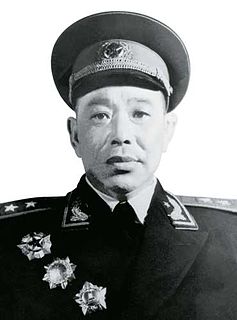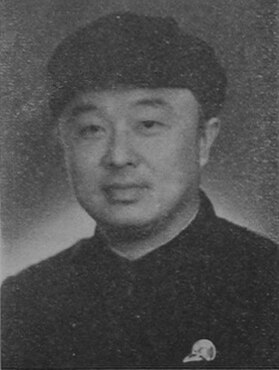
Zhejiang University, abbreviated as ZJU or Zheda and formerly romanized as Chekiang University, is a national public research university based in Hangzhou, Zhejiang, China. It is a member of prestigious C9 league and is the only university in Zhejiang selected into national higher education plans including Project 985, Project 211 and Double First Class University Plan. Consistently ranked among the top 5 academic institutions in mainland China, ZJU is ranked 5th in Asia and 42nd globally by the QS University Rankings as of 2022.

Ye Ting, born in Huiyang, Guangdong, was a Chinese military leader who played a key role in the Northern Expedition to reunify China after the 1911 Revolution. After serving with the Kuomintang, Ye later joined the Communist Party of China (CPC).

Luo Xian Xiang (1890–1968) was a World War II Chinese general. He was a soldier, and at times, as regional government official; he established anti-corruption policies and conducted administrative and education reforms. He was born in Sihui, Guangdong Province, where Cantonese is the native tongue.

Li Zhimin (李志民 or 李凤瑞 or 李明阶; pinyin: Lǐ Zhìmín or Lǐ Fèngruì or Lǐ Míngjiē; July 9, 1906 – November 16, 1987) was a general of the People's Liberation Army from Liuyang, Hunan. Li was the former political commissar and director for the Political Department of the Chinese People's Volunteers.
Zhao Boping was a People's Republic of China politician. He was born in Lantian County, Xi'an, Shaanxi Province. He joined the Chinese Communist Party in February 1927. He was governor of his home province. He was Communist Party Secretary of Xi'an from December 1949 to 1956.

Liu Xiao was a Chinese diplomat. He was born in Hunan Province. He joined the Communist Party of China in 1926. He was Ambassador of China to the Soviet Union (1955–1962) and Albania.
Qin Hezhen was a People's Republic of China politician. He was born in Jinxiang County, Shandong Province. During the Second Sino-Japanese War, he formed a guerrilla force to fight the Empire of Japan invaders. This force was later incorporated into the Eighth Route Army and was active on the border between Shandong, Jiangsu and Henan provinces. He also participated in the Chinese Civil War that followed. In 1977, Qin was made vice-governor of Shandong and became chairman of the provincial people's congress in 1983. He was a delegate to the 6th National People's Congress and the 7th National People's Congress.
Yan Dakai was a People's Republic of China politician. He was born in Laoting County, Hebei. He was CPPCC Committee Chairman of his home province (1964–1967) and Tianjin (1979–1980). He was a delegate to the 4th National People's Congress and 5th National People's Congress and a member of the Central Advisory Commission.
Wang Maolin is a Chinese politician. He was born in Qidong, Jiangsu. He joined the Chinese Communist Party in 1956. He was mayor (1982–1985) and Communist Party Secretary (1985–1987) of Taiyuan. He was Communist Party Secretary (1991–1993) and CPPCC Committee Chairman (1993) of Shanxi. He was Communist Party Secretary (1993–1999) and People's Congress Chairman (1998) of Hunan.

Tao Yong was a Chinese military leader. He served as Deputy Commander of the People's Liberation Army Navy (PLAN) and Lieutenant General of the People's Liberation Army.
Fan Qing was an early figure in the Communist Party of China, and a spy for the Kenpeitai.
Ma Shouyu was a political figure in the People's Republic of China.

Lin Feng was a Chinese male politician, who served as the vice chairperson of the Standing Committee of the National People's Congress.
Li Suwen was a Chinese politician who served as the vice chairperson of the Standing Committee of the National People's Congress.

Liao Hansheng was a Chinese male politician, who served as the vice chairperson of the Standing Committee of the National People's Congress.

Sun Qimeng was a Chinese male politician, who served as the vice chairperson of the Standing Committee of the National People's Congress.
Gan Ku was a Chinese male politician, who served as the vice chairperson of the Standing Committee of the National People's Congress.
Jiang Zhenghua is a Chinese male politician, who served as the vice chairperson of the Standing Committee of the National People's Congress.
Sheng Huaren was a Chinese male politician, who served as the vice chairperson of the Standing Committee of the National People's Congress.
Yang Shixian was a Chinese chemist, who was a member of the Chinese Academy of Sciences.












